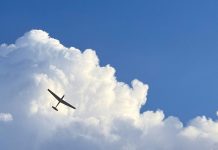
In this close call from 2012, Terry Anderson thanks his instructor for the flying lessons and general attitude that made a night engine failure survivable
I was to ferry a Cessna 182, fresh out of a 100-hourly inspection, from Bankstown to Moruya via Goulburn to be ready for a weekend’s skydiving. I love my flying and get quite a buzz from flying at night. For this reason I elected to wait until it was dark before departing from Goulburn for the final leg to Moruya. I expected a dark night with little wind below 3000ft. and was really looking forward to this sector.
Flying for me started back in 1976. I was a teenager when I was introduced to hang gliding, instantly falling in love with the sport. I pretty much taught myself to fly because in those days there weren’t too many experienced pilots around. Looking back, I don’t know how I survived those formative years. Many people died, some of whom were my friends.
By June 1998, I had accumulated 22 years of experience, where every out landing I did in a hang glider was a forced landing. You don’t have the luxury of a go-around if you get it wrong. Over those years I became quite skilled at moving with and through the magical three-dimensional ocean of air.
On 29 April 1978, I added a new dimension to my flying and began learning to fly aeroplanes. I had a brilliant instructor in Corinne Nugent. What I remember best is her dictum that ‘anything man-made is prone to failure’.
That saying created an attitude. While thoroughly enjoying my flying, I would always plan for the worst. For example, before I line up and roll I know where I want to put her down if the engine goes at 300ft.
I am fortunate to have accumulated 1500 hours of throwing people out of aeroplanes. In my limited experience, flying for skydive operations is just about the most fun thing you can do with an aeroplane. It provides the unique opportunity to land every 25 minutes. I might do this 20 times a day and I don’t waste this valuable resource. I practise engine-out approaches (yes, I do watch shock cooling), really long straight-ins, or sometimes, more conventional scenarios within the circuit pattern. I change the scenarios to hone my judgement, but I never change the spot − it’s always the threshold. In the event of a real engine out I can put that spot anywhere I want.
At Bankstown that day I bought some new gel cups for my headset. The first leg was uneventful. My wife Jacqueline met me at Goulburn Airport, where we shared dinner just before sunset. I wanted genuine night VFR so I waited a good 90 minutes until it was truly dark.
With checks complete and a clear plan to gain extra height before departure in my head, I lined up on 22. Corinne taught me many years ago that if you are going to have an engine failure Murphy says it will be during the first four minutes of take-off. The only height you can’t use is that above you, so I always make sure I have height to spare before departing at night.
As I throttled up I became aware that the engine sounded different, but all the numbers were good so I put it down to the new gel cups on my headset. I continued to rotation.
I planned high, and Melbourne Centre subsequently gave me a clearance to enter the control area. On track for Moruya and still climbing, with Goulburn around six or 7nm behind me, I heard a loud bang followed immediately by very strong vibrations. At first I thought part of the prop had fractured, causing the imbalance, but I very quickly realised I had suffered engine failure. That, on a black night in a single, is a pilot’s nightmare.
I know all my emergency drills instinctively, but I knew I wouldn’t be able to fix this. So my first drill was to soil myself (gotta keep a sense of humour). I immediately came about and pointed the nose to Goulburn. I was in controlled airspace and when established in a stable glide I called Centre to advise them of the emergency and asked them to stand by while I assessed my options.
I remember feeling great fear; something I thought would never happen to me. I have been placed in harm’s way many times in my life and I have always kept a level head. Panic was a new experience for me. I quickly became aware I was hyperventilating. The truth is I was thinking, ‘this is it. I’m going to die tonight!’
Then something clicked and I took control. I told myself out loud: ‘Aviate, you can do this. Fly it to the ground. Just breathe.’ I remember that vividly. I could still see the runway lights in the distance. My breathing slowed, but the lights really were a long way off. The picture was tight. I remember saying to myself ‘what are you worried about, it’s just a big glider?’ From that point on I was in charge and not the aeroplane. I decided the field was achievable.
This all happened, I guess, in the first 30 seconds, but it felt like forever. The initial fear had gripped me round the throat, but I got on top of it quickly.
Melbourne asked how I was going and whether I wanted services? Police, ambulance, fire brigade, mortician, let the guys at the drop zone know I wouldn’t be in tomorrow, feed my dog? It felt that to accept would be to admit I might not make it. My answer was No. I will be fine.’ I wanted no doubt in my mind that I would make it. In hindsight, I should have said yes.
I had a parachute but I had put it in the back; too uncomfortable. But I did give serious consideration to donning it and going for help. Exiting an aircraft at night under canopy holds no fear for me: I have done it many times for fun. I couldn’t guarantee where the aircraft would end up though, so I dismissed that option.
Now focused on the glide, my sole purpose was to make the runway move under the initial angle of its first sighting from the established glide (arrive high) and keep it there. The best I could do however was to keep the runway at almost the same relative position within my field of vision. Unless I struck a stronger headwind (and I knew that wouldn’t happen) I would only scrape in by the skin of my teeth.
I remember feeling confident during the glide and I relaxed into it making over the top with 900 feet, setting up finals on 04 rather than 22 (fewer obstacles). This would not have been possible if I hadn’t gained extra altitude before departure (thank you Corinne). Touchdown was halfway down 04 and I had just enough speed to roll onto the apron. When I stopped I called Centre and told them I was down safely and the runway was clear.
I was pumped, shaking from pure adrenalin. Everything I had ever done in an aeroplane, hang glider or in freefall, and even the time I spent in the army reserve as an infantry section commander learning to work under extreme stress, had brought me to this point. All the values I had absorbed about being professional, being precise, uncompromising and critical of myself had saved my life.
I was truly humbled by the experience. Corrine once said words to the effect of, ‘anyone can learn to fly an aeroplane, but when it all goes pear-shaped can you handle it? Then you will know if you are a pilot.’
After all these years, I am still learning.
Anything man-made is prone to failure. Your life and your passengers’ lives depend on you understanding this.





Comments are closed.